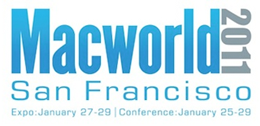So How Was Macworld This Year?
 I had fun speaking at Macworld about the future of the mobile market last Wednesday. (Below, for no particular reason other than that I like it, is an image from my presentation–making the point that Android is less like Windows and more like Linux–actually, it is Linux under the skin.) I had even more fun listening to the guy who spoke after me–Bill Atkinson, who was one of the principal creators of the Mac in the early 1980s and who’s now (among other things) an iPhone developer. And I enjoyed walking the show floor Thursday morning.
I had fun speaking at Macworld about the future of the mobile market last Wednesday. (Below, for no particular reason other than that I like it, is an image from my presentation–making the point that Android is less like Windows and more like Linux–actually, it is Linux under the skin.) I had even more fun listening to the guy who spoke after me–Bill Atkinson, who was one of the principal creators of the Mac in the early 1980s and who’s now (among other things) an iPhone developer. And I enjoyed walking the show floor Thursday morning.
When Apple announced in December of 2008 that it was puling out of Macworld, there were plenty of folks who predicted that the show would be dead within a year or two. And it did go through a great downsizing in 2010–but it may have found a new, more modest equilibrium. The show had 270 exhibitors this year and conference organizer IDG says it went into the event expecting 25,000 attendees; last year’s edition had “over” 250 exhibitors and “more than” 20,000 attendees. (The 2009 show, the last that Apple was present for, had 400 exhibitors and more than 28,000 attendees.)
Comparing these sorts of numbers can be tricky–a meaningful percentage of the 2010 and 2011 exhibitors had very small tabletop displays, for instance. Despite the “Mac” in “Macworld,” the percentage of show space devoted to iPhone- and iPad-related accouterments was high. And while a lot of major companies once attended the show, the only big outfits with big booths I noticed at the 2011 edition were HP and Fujitsu. (Some other sizable companies, such as Monster Cable, had smaller presences.)
Overall, the feel was low-key, not splashy. But it was also active: The show floor (now at the Moscone Center’s smaller-but-nicer Moscone West building) was crowded with consumers when I visited.
 I was, however, struck by the age of the attendees I saw as I strolled the floor on Thursday morning–I saw way more middle-aged people and senior citizens than the young, trendy folk who fit the classic Apple-customer stereotype. Many of the men and woman I saw looked like they’d been attending Macworld forever. (For what it’s worth, the attendee quoted in the San Jose Mercury News’s story is a 73-year-old lady who’s been going to Macworld Expo for a quarter century.)
I was, however, struck by the age of the attendees I saw as I strolled the floor on Thursday morning–I saw way more middle-aged people and senior citizens than the young, trendy folk who fit the classic Apple-customer stereotype. Many of the men and woman I saw looked like they’d been attending Macworld forever. (For what it’s worth, the attendee quoted in the San Jose Mercury News’s story is a 73-year-old lady who’s been going to Macworld Expo for a quarter century.)
Are younger people less likely to get into the habit of attending a show like Macworld? When Apple quit the event, it said the decision was based in part on the existence of its Apple Stores. They do indeed feel like miniature product fairs that are done Apple’s way and open year-round. And the iOS (and now Mac) App Stores let you explore the world of available software right from your phone, tablet, or computer. But if the only places you see Apple-related products in person are operated by Apple, you’re getting an incomplete view of the Apple ecosystem.
For instance, the largest Macworld booth is the one for HyperMac, which makes external batteries for MacBooks, iPads, and other Apple gizmos. Their products are unlikely to show up in the Apple Store anytime soon–a few months ago, Apple was suing the company over its use of MagSafe connectors–but they’re cool. (I picked up one myself at the show.) I also appreciated getting hands-on time with Zagg’s Zaggmate iPad case/keyboard; like all keyboards, it’s tough to judge until you’ve seen it and touched it. (As far as I know, the only keyboards in Apple Stores are Apple-branded ones.)
In short, I miss the old Macworld–but I’m glad that reports of the event’s death turned out to be so greatly exaggerated. Next year’s show is scheduled for January 26th-28th, 2012, and I plan to be there…
[Full disclosure: I’m a former employee of IDG, Macworld’s owner, and still participate in the company’s employee stock-ownership plan.]
Comments are closed
Read more:













By Harry McCracken | Monday, January 31, 2011 at 9:13 am